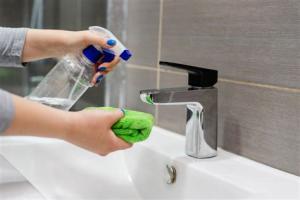Ultimate Guide: How to Effectively Clean Limescale Off Taps

-
Quick Links:
- Introduction
- Understanding Limescale
- Why Limescale Forms on Taps
- Tools and Materials Needed
- Step-by-Step Guide to Cleaning Limescale Off Taps
- Natural Remedies for Limescale Removal
- Store-Bought Solutions
- Preventing Limescale Buildup
- Case Studies
- Expert Insights
- FAQs
Introduction
Limescale is a common household nuisance, particularly in areas with hard water. If you've noticed unsightly white or chalky deposits on your taps, you're not alone. This guide will provide you with comprehensive methods to effectively clean limescale off taps, ensuring they shine like new!
Understanding Limescale
Limescale primarily consists of calcium carbonate, which precipitates out of hard water as it evaporates. This buildup can occur on various surfaces, including faucets, showerheads, and other plumbing fixtures. Understanding its composition and behavior will give you insights into effective cleaning methods.
Why Limescale Forms on Taps
Limescale forms when hard water evaporates and leaves behind mineral deposits. Factors contributing to limescale formation include:
- Hard Water: High mineral content in water.
- Poor Ventilation: In humid environments, water evaporates slowly.
- Temperature: Hot water tends to evaporate faster, leading to increased deposits.
Tools and Materials Needed
Before you start cleaning, gather the following materials:
- White vinegar or lemon juice
- Baking soda
- Spray bottle
- Soft cloth or sponge
- Old toothbrush
- Rubber gloves
- Commercial limescale remover (optional)
Step-by-Step Guide to Cleaning Limescale Off Taps
Step 1: Prepare the Area
Clear the sink area and gather your cleaning supplies. Protect surrounding surfaces by placing a cloth or old towel around the tap.
Step 2: Apply Vinegar Solution
Fill a spray bottle with equal parts water and white vinegar. Spray the solution generously on the limescale-affected areas of the tap.
Step 3: Let it Sit
Allow the vinegar solution to sit for 10 to 15 minutes. This will help dissolve the limescale buildup.
Step 4: Scrub the Area
Use a soft cloth or sponge to scrub the tap, focusing on areas with heavy limescale deposits. For hard-to-reach spots, an old toothbrush can be effective.
Step 5: Rinse and Dry
Rinse the tap thoroughly with warm water to remove any residue. Dry with a clean cloth for a streak-free finish.
Step 6: Repeat if Necessary
If limescale persists, repeat steps 2 to 5 or try adding baking soda to the vinegar solution for extra scrubbing power.
Natural Remedies for Limescale Removal
Several natural remedies can also be effective in removing limescale:
- Lemon Juice: Its acidity can break down mineral deposits.
- Baking Soda Paste: Mix baking soda with water to form a paste; apply it to the tap and scrub gently.
Store-Bought Solutions
If natural remedies aren't effective, consider using commercial limescale removers. Ensure to follow the manufacturer's instructions and safety precautions.
Preventing Limescale Buildup
Taking proactive steps can help prevent limescale from forming in the first place:
- Wipe down taps after use to remove excess water.
- Install a water softener to reduce mineral content in your water supply.
- Use a descaler regularly to maintain clean taps.
Case Studies
To illustrate the effectiveness of these cleaning methods, consider the following examples:
Case Study 1: Household with Hard Water
A family in a hard water area reported significant limescale buildup on their kitchen tap. After implementing a regular cleaning routine with vinegar and baking soda, they noticed a drastic reduction in deposits.
Case Study 2: Public Restroom Maintenance
A local government facility found that using commercial limescale removers weekly helped maintain clean taps, improving the overall appearance and hygiene of the restroom.
Expert Insights
Experts recommend combining both natural and commercial solutions for the best results. Regular maintenance is key to preventing limescale buildup and prolonging the lifespan of your taps.
FAQs
1. What is limescale?
Limescale is a hard, chalky deposit primarily made up of calcium carbonate, formed from hard water.
2. How often should I clean limescale off my taps?
It’s advisable to clean taps at least once a month to prevent heavy limescale buildup.
3. Can I use bleach to remove limescale?
Bleach is not recommended for limescale removal, as it can damage finishes and does not effectively dissolve mineral deposits.
4. Is vinegar safe for all types of taps?
Vinegar is generally safe for most taps, but it’s best to test a small area first, especially on polished finishes.
5. Will hard water damage my taps?
Yes, over time, hard water can lead to corrosion and damage to the finish of your taps if not properly maintained.
6. What is the best way to prevent limescale?
Wiping down taps after use and installing a water softener are effective preventive measures.
7. How do I remove limescale from a showerhead?
Remove the showerhead and soak it in a vinegar solution for several hours, then scrub and rinse thoroughly.
8. Are there eco-friendly limescale removers?
Yes, products with citric acid or natural ingredients can be effective for eco-conscious cleaning.
9. Can I use a magic eraser on limescale?
Magic erasers may work on some surfaces but can scratch delicate finishes; use with caution.
10. How long does it take for vinegar to dissolve limescale?
Vinegar typically takes 10 to 15 minutes to effectively dissolve limescale, depending on the thickness of the deposits.
Random Reads
- How to remove oil stains with baking soda
- How to open a combination lock
- How to oil ceiling fan
- How to create a discord channel on android
- How to wire a contactor
- How to wire a 3 way switch
- How to catch victini pokemon black white
- How to reboot dsl modem remotely
- How to reattach a keyboard key
- How to reset your graphics drivers